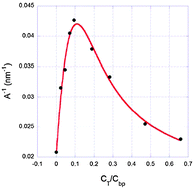DNA interaction with Actinomycin D: mechanical measurements reveal the details of the binding data
Abstract
We have studied the interaction between the anticancer

* Corresponding authors
a
Departamento de Física, Universidade Federal de Viçosa, Viçosa, Minas Gerais, Brazil
E-mail:
marcios.rocha@ufv.br
Fax: +55-31-3899-2483
Tel: +55-31-3899-3399
b Departamento de Física, Universidade Federal de Minas Gerais, Belo Horizonte, Minas Gerais, Brazil
We have studied the interaction between the anticancer

 Please wait while we load your content...
Something went wrong. Try again?
Please wait while we load your content...
Something went wrong. Try again?
E. C. Cesconetto, F. S. A. Junior, F. A. P. Crisafuli, O. N. Mesquita, E. B. Ramos and M. S. Rocha, Phys. Chem. Chem. Phys., 2013, 15, 11070 DOI: 10.1039/C3CP50898F
To request permission to reproduce material from this article, please go to the Copyright Clearance Center request page.
If you are an author contributing to an RSC publication, you do not need to request permission provided correct acknowledgement is given.
If you are the author of this article, you do not need to request permission to reproduce figures and diagrams provided correct acknowledgement is given. If you want to reproduce the whole article in a third-party publication (excluding your thesis/dissertation for which permission is not required) please go to the Copyright Clearance Center request page.
Read more about how to correctly acknowledge RSC content.
 Fetching data from CrossRef.
Fetching data from CrossRef.
This may take some time to load.
Loading related content
